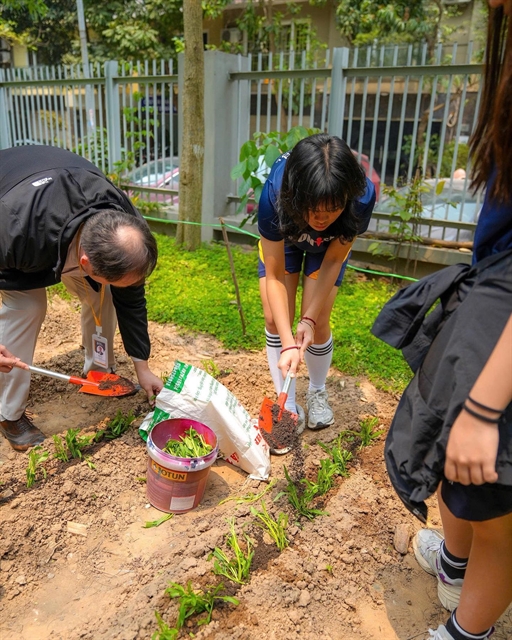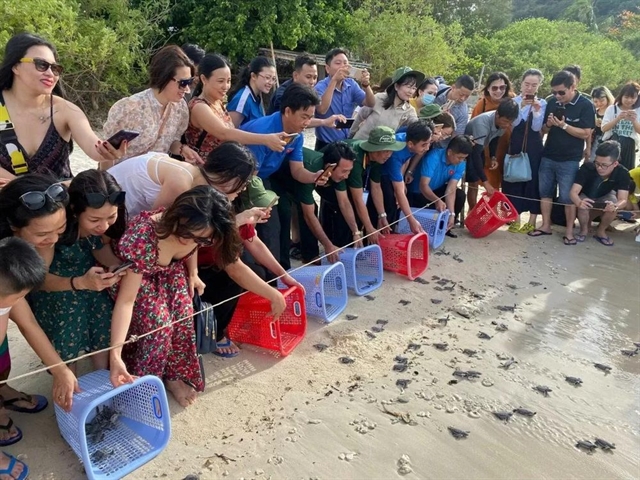 Environment
Environment

 |
| Trần Đình Đồng checks a turtle egg-laying site on Bảy Cạnh Islet. Photo congthuong.vn |
BÀ RỊA-VŨNG TÀU – Soldiers at border guard stations on Côn Đảo Island are working to keep the environment green and healthy.
In the past, to reach Côn Đảo Island in Bà Rịa-Vũng Tàu Province, people had to journey for around 12 hours by boat from Cát Lở Port in Vũng Tàu City.
The boat schedule was updated monthly and no cancellations were announced in advance, with all departures depending on weather conditions.
The lives of the islanders depended heavily on these boats. During stormy days, when the boats couldn't run, goods did not reach the island, meaning the island could easily see a food shortage.
Political commissar of Côn Đảo Border Guard Station Lieutenant Colonel Nguyễn Văn Năng, 46, has a lot of experience on the island.
In the eight years since he took the job on Côn Đảo, he has seen dramatic changes, particularly the addition of high-speed ferries from Sóc Trăng Province and the cities of Vũng Tàu, Cần Thơ and HCM City, as well as direct flights to the island.
“In previous years, it took half a day to reach the island by boats. Notably, in rough sea or storms, the boats could not run,” Năng told congthuong.vn.
“Now, there are high-speed boats that takes only four hours to get to the island. This means that goods are always abundant,” he said.
Protecting the forests of Côn Đảo is an important task for the border guard soldiers. In the middle of the vast ocean, forests are like green lungs for the island. Fresh water — one of the vital conditions for survival — can only be retained due to the forests.
Soldier Trần Mạnh Hùng from Hà Tĩnh Province, head of the Bảy Cạnh Islet Forest Ranging Station, has 33 years of experience protecting the forests on the islets of Côn Đảo. He said that he has lived on every one of the 16 islands except for Hòn Tài islet.
Recalling the hardship of decades past, he said: “Back then, the toughest challenge was fresh water. We had to carry each can of water up to the islet. During stormy seasons, two of us only had 40 cans of fresh water for half a month. Later, we got 200-litre barrels, which we carefully rationed to last a week.”
“In the early years of guarding the islet, we had no shelter, so we had to cut bamboo to build huts and use forest leaves for rain cover. Resources were scarce. Côn Đảo National Park only had one or two boats,” Hùng explained.
“There were years when the sea was too rough to reach the main island, so we had to celebrate Tết on the islet. When food ran out and we could not catch fresh fish, we had to resort to eating dried fish,” he said.
“Nowadays, we have electricity, fresh water and phone signals. Food is more abundant too. But after so many years living on the islet, I have grown used to it. I feel uneasy on the mainland, so even if I go back, it is only for a day or two before I pack up and return to guard the islet,” he added.
Sea turtle midwives
 |
| Tourists releasing baby turtles into the sea. Photo congthuong.vn |
Côn Đảo is considered a haven for sea turtles. In the past, the surrounding waters were home not only to green turtles, but also hawksbill and olive ridley turtles. Now, the green turtle is the most common.
Years ago, Côn Đảo residents saw turtles as a food source, harvesting their meat and eggs with little restraint.
In 1991, the first turtles were released with support from the Côn Đảo forest protection officials. In 1993, the Côn Đảo National Park was officially established. However, it was not until 2014, when turtle poaching became a criminal offence, that attitudes began to shift meaningfully.
Along with guarding the forests and island, soldiers at the Bảy Cạnh Islet Forest Ranging Station also take on a crucial role as 'midwives' for sea turtles.
Trần Đình Đồng, from the central province of Quảng Bình, said that in Côn Đảo, there are a total of 18 turtle egg-laying grounds. A large majority — 80 per cent — of the turtles come to lay their eggs on Bảy Cạnh Islet every year, with the islet's Bãi Cát Lớn beach being their favourite place during the breeding season.
The turtles lay their eggs from April to October every year, with most of the eggs laid between May and August.
“At this time of year, there are nights when we only get two or three hours of sleep because we have to watch for nesting turtles,” said Đồng.
“Some nights we stay awake entirely, especially when there are mother turtles struggling to lay eggs, which need constant monitoring. In June and July, volunteers will come to help us with this work,” he said.
“During this time, all movement along the beaches and in the waters in front of the nesting sites is suspended daily from 3pm until 8am the following morning. In particular, boats are not allowed to anchor in the waters of Cát Lớn beach. To access Bảy Cạnh Islet, people must take a canoe to Bờ Đập beach instead,” he said.
Đồng explained that allowing turtles to nest and incubate naturally on the beach poses several risks: rising tides may flood the nests and spoil the eggs, other turtles may dig new nests that inadvertently damage previously laid clutches, lizards may prey on the eggs, and humans may steal them if vigilance lapses.
To ensure high egg and hatchling survival rates, assisting turtles in the nesting process has therefore become a critical part of soldiers' work.
“Each year, the station assists around 300 to 400 mother turtles. We tag each one for tracking purposes. During the nesting season, a female turtle typically comes ashore to nest three to nine times, laying nearly one hundred eggs each time. The record for the highest number of eggs laid in a single clutch is 192. Our station's hatching rate is over 80 per cent,” said Đồng.
Despite the large number of eggs and nesting turtles, Đồng said that long-term survival rate remains extremely low — only about one in 1,000 hatchlings survives to adulthood, typically after 20 to 30 years.
“The work is tough, so everyone on the islet is truly dedicated. We watch over the turtles, protect the nests and relocate eggs to the incubation site when needed. The more we do it, the more passionate we become about sea turtle conservation. We hope future generations can still witness these magnificent creatures in the wild, not just in books,” Đồng said with emotion.
The Côn Đảo of today owes much to the tireless patrols and watchful nights of border guards like Năng, and the dedication of conservationists like Hùng and Đồng, who have worked to protect the area's diverse forests and marine ecosystems.
“I just hope my wife and children at home understand and support my work so I can focus on my duties and fulfil the responsibilities I have been entrusted with,” Đồng said. VNS




